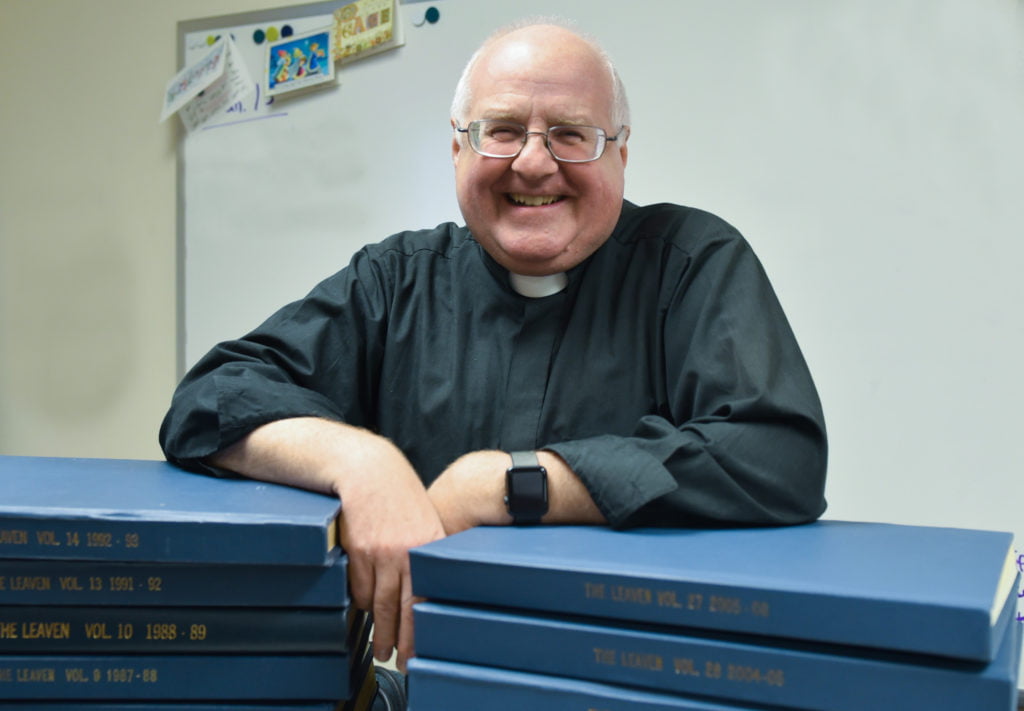
Father Mark Goldasich is the pastor of Sacred Heart parish in Tonganoxie. He has been editor of the Leaven since 1989.
by Father Mark Goldasich
I caught some movement out of the corner of my eye as my mom and I were heading out of Zaxby’s this past Sunday.
As we reached the door, a woman brushed past us. She was obviously in a hurry — not to leave, but to hold the door open so that I could easily maneuver Mom’s wheelchair. Once through one door, she proceeded to hold open the second.
Both Mom and I thanked the woman for her thoughtfulness. I said, “You can’t believe what a huge help that is when pushing a wheelchair.”
She replied, “Oh, I do know. I’ve pushed my share of strollers and always appreciated a little help with the doors.”
After wishing her a great Sunday, Mom and I talked about how many good people there are in the world.
Those little gestures of kindness mean a lot. Someone who understood that well was Marie Françoise Martin, better known as St. Thérèse of the Child Jesus, the “Little Flower.” Many people are familiar with her story, but here’s a refresher course in honor of her feast day on Oct. 1.
She was born in 1873, the youngest of five sisters. All would eventually become nuns, four of them at the Carmelite monastery in Lisieux. When Marie was 4, her mother died. Consequently, she became very close to her sister Pauline, who left for the convent in Lisieux when Marie was 9.
Although she longed to join her sister, Marie had to wait until she was 15, still such an unusually young age that she needed the permission of the diocesan bishop to do so.
Given the religious name of Thérèse, she was assigned the lowliest housekeeping tasks, to keep her from receiving any special treatment because of her age.
It was here that Therese developed her “Little Way,” believing “that every act, no matter how great or small, brings us as close to God as do heroic acts performed by spiritual giants such as Ignatius of Loyola or Teresa of Avila” (From the second edition of “Companion to the Calendar: A Guide to the Saints, Seasons and Holidays of the Year”).
“To pick up a pin for love can convert a soul,” she once said.
Thérèse’s great desire was to join a missionary Carmel (or Carmelite monastery) in Vietnam. Sadly, she was unable to do so because she developed tuberculosis, a disease that took her life at age 24.
We’d likely know little to nothing about Thérèse of Lisieux or her “Little Way” had she not been instructed to write down her story by the prioress of her Carmel — her sister Pauline. Her work has now been translated into 50 languages, inspiring readers from all walks of life to strive for holiness in their mundane, day-to-day activities.
How many times each day do we pass up opportunities to do good for others because we believe that our little gestures won’t make any difference? Or how often do we assure ourselves that we’ll get to living out our faith “a little later.” This poem captures that feeling well:
“I shall do so much in the years to come,/ but what have I done today?/ I shall give out gold in princely sum,/ but what did I give today?/ I shall lift the heart and dry the tear,/ I shall plant a hope in the place of fear,/ I shall speak with words of love and cheer,/ But what have I done today?
“I shall be so kind in the after while,/ But what have I been today?/ I shall bring to each lonely life a smile,/ but what have I brought today?/ I shall give to truth a grander birth,/ And to steadfast faith a deeper worth,/ I shall feed the hungering souls of earth,/ But whom have I fed today?” (Found in Anthony Castle’s “More Quips, Quotes & Anecdotes for Preachers and Teachers.”)
In honor of the “Little Flower,” what little action can you do each day of October to brighten the life of someone?
Don’t put off this work of becoming a saint. Let St. Thérèse show you the way . . . little by little.

